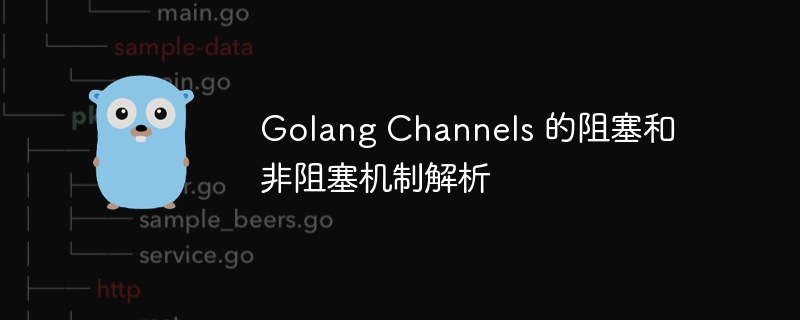

Golang Channels blocking and non-blocking mechanism analysis
Introduction:
Channels is one of the important concurrent communication mechanisms in Golang, which allows different Goroutines to communicate and synchronize between them. When using Channels, we often encounter blocking and non-blocking situations. This article will introduce the blocking and non-blocking mechanisms of Channels, and illustrate its principles and usage through code examples.
In Golang, we can implement blocking and non-blocking mechanisms in the following two ways: using the length of the Channel and using the select statement. Below we will introduce them one by one.
Code example:
package main
import "fmt"
func main() {
ch := make(chan int) // 创建一个无缓冲 Channel
go func() {
fmt.Println("开始写入数据")
ch <- 1 // 写入数据到 Channel
fmt.Println("数据写入成功")
}()
fmt.Println("等待读取数据")
data := <-ch // 从 Channel 读取数据
fmt.Println("读取到数据:", data)
}In the above code, we create an unbuffered Channel ch. In the main function, we start a Goroutine that writes data to Channel ch. In the main Goroutine, we try to read data from Channel ch, and since there are no other Goroutines waiting to write on this Channel, the read operation is blocked. The read operation will not continue until the Goroutine that wrote the data has finished executing.
In the select statement, we can monitor the read and write operations of multiple Channels at the same time. When one or more Channels are ready, the select statement randomly selects an executable operation for execution. If no Channel is ready, the select statement will enter the blocking state until at least one Channel is ready.
Code example:
package main
import "fmt"
func main() {
ch1 := make(chan int)
ch2 := make(chan int)
go func() {
ch1 <- 1
}()
go func() {
ch2 <- 2
}()
fmt.Println("开始监听 Channel")
select {
case data := <-ch1:
fmt.Println("从 ch1 中读取到数据:", data)
case data := <-ch2:
fmt.Println("从 ch2 中读取到数据:", data)
}
}In the above code, we created two Channels ch1 and ch2, and started two Goroutines respectively. Write data to the two Channels respectively. In the main Goroutine, we use the select statement to select an executable operation from multiple Channels. Since both Channels are ready, the select statement will randomly select one of the executable operations for execution.
Conclusion:
Through the introduction and code examples of this article, we have learned about the blocking and non-blocking mechanisms of Golang Channels. In actual development, we need to choose the appropriate method according to different needs and scenarios. Whether using the length of the Channel or using the select statement, Golang's concurrent communication mechanism can provide flexible and efficient concurrent processing capabilities. When writing concurrent programs, we should have a deep understanding of blocking and non-blocking mechanisms, and rationally choose appropriate processing methods to ensure the correctness and performance of the program.
Reference materials:
(Number of words: 819 words)
The above is the detailed content of Analysis of blocking and non-blocking mechanisms of Golang Channels. For more information, please follow other related articles on the PHP Chinese website!
 How to define variables in golang
How to define variables in golang
 What are the data conversion methods in golang?
What are the data conversion methods in golang?
 What are the commonly used libraries in golang?
What are the commonly used libraries in golang?
 What is the difference between golang and python
What is the difference between golang and python
 What are the application scenarios of PHP singleton mode?
What are the application scenarios of PHP singleton mode?
 what is mac address
what is mac address
 How do PR subtitles appear word for word?
How do PR subtitles appear word for word?
 How to open a 404 website
How to open a 404 website




